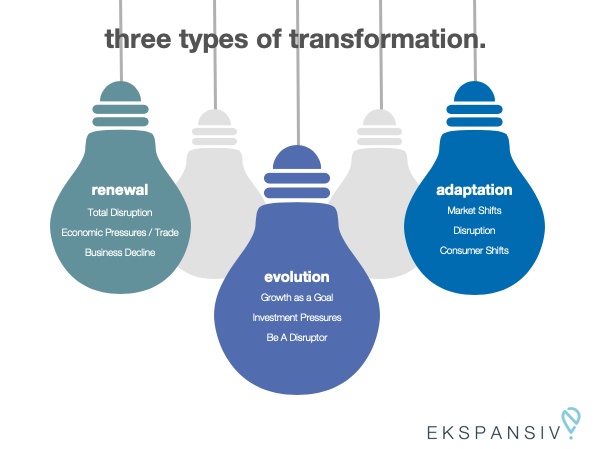A digital transformation doesn’t have to be expensive and it doesn’t have to involve the entire business, which is often, wrongly, assumed. The word transformation itself conjures up images of doing something completely and utterly different. Senior management may see it as a huge expense, whereas employees will think it means getting rid of their jobs. In some cases, all the above are true, but there’s a reason. If that’s happening it’s for one of the reasons below. Here are the three types of digital transformation we have come to see.
1. Renewal: This is the scary one. For it means that the business is in rough shape. Likely a shrinking market or a market under significant pressures. The business is struggling to stay relevant in the face of new entrants disrupting them, regulatory changes…any number and mix of issues. The only way to survive is to renew the whole business, a complete transformation. In those situations, efficiencies through job loss often do happen, entire business models change.
2. Evolution: For companies in this space, they are usually facing some external pressures and may be seeing declining revenues, but are acutely aware of the problems they face in the future. It is also likely that the whole business or industry isn’t in trouble, rather, certain parts. It may be that only the supply chain or customer journey needs digitizing. This is an evolution. It’s less expensive and can often be done fairly quickly with employees being augmented by technology, not replaced.
3. Adaptation: This is the best place to be in the sphere of digital transformation. The business may not know exactly what the problem is, but they know there’s a problem somewhere. They may also be aware that competitors or new entrants are looming. The business is still relatively healthy or is perceived to be at it’s pinnacle with only small, incremental growth opportunities but wants to grow more and seek new markets or new add on revenue streams.
This is of course, a fairly high-level look at the three types of digital transformation and from our perspective. Some organisations may be between one of the stages. But before any organisation undergoes any form of transformation, it’s key to understand your situation and the desired end-goal. It’s also absolutely critical to understand you organisations people and culture, for no type of transformation is successful without addressing people and culture. But that’s another post! The major consulting firms often have us thinking digital transformations are massive and expensive. They don’t have to be. And that’s another post!



Leave a comment